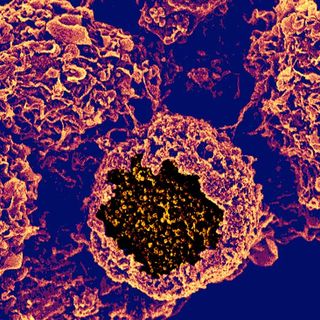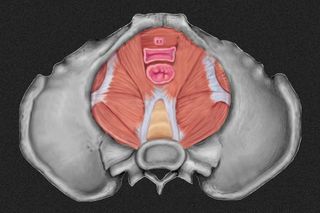
Having a Baby Doesn’t Mean You Have to Pee When You Sneeze For the Rest of Your Life
All about how childbirth can weaken your pelvic floor muscles — and how to rebuild them.

Pregnancy changes a woman’s body, we all know that. But not all post-pregnancy changes to the body are inevitable. Many women hear that peeing when you sneeze is a fact of life, post-pregnancy. It isn’t! We need to talk more about what ends up happening to the pelvic floor — the muscle that, when weakened, can cause incontinence after pregnancy — after childbirth, and what changes can be prevented or fixed with Kegels and other exercises.
What is the pelvic floor?
It’s the intense web of muscles, ligaments and tissues that spreads between one’s pelvic bones.
What does the pelvic floor do during pregnancy and childbirth?
Pelvic floor muscles provide support for the baby during pregnancy and allow the baby’s passage through the birth canal during childbirth. In a best-case scenario, strong pelvic floor muscles stretch to allow the baby to pass through it, then return to their normal state. However, for many women, their pelvic floor is weak to begin with, and childbirth can exacerbate this muscle weakness, leading to a host of problems.
Pelvic floor weakening can start during pregnancy. But during childbirth, pressure from the baby’s weight during labor, as it passes via the birth canal, can cause the pelvic floor muscles to become stressed and weaken, too. Sometimes, this same pressure may end up damaging nerves in the pelvic floor, leaving women with little to no control over the actions of these muscles. Conversely, childbirth may also leave pelvic floor tissue inflamed. Other factors that lead to a weak or damaged pelvic floor include fluctuating hormone levels, and such as the use of forceps or vacuum during delivery.
What postpartum do women experience related to their pelvic floor?
Weakened pelvic floor muscles, damaged nerves, or both, can cause several postpartum complications, most commonly postpartum incontinence (also known as stress incontinence) — that is, the peeing or leaking of urine when you sneeze, cough, laugh, bend, or simply even walk. Or, a weak pelvic floor may cause the urge to urinate frequently and suddenly, even when your bladder is empty, a condition known as urge incontinence. Some women experience trouble starting the flow of urine, or emptying the bladder completely.
Another, more serious condition a weakened pelvic floor could lead to is pelvic organ prolapse, which may manifest soon after, or years after, giving birth. Pelvic organ prolapse is most common after multiple pregnancies or complicated deliveries have weakened pelvic floor muscles so much they can’t keep pelvic organs (the bladder, rectum and uterus) from ‘slipping’ down from their position in the torso to press into or out of the vagina. This can cause pelvic pain, pain during intercourse, a feeling of fullness in the pelvis, and/or back pain.
Pain during intercourse may also be due to inflamed pelvic floor tissues and nerve endings.
Can I avoid these postpartum pelvic floor complications?
Yes! Starting Kegels and other pelvic floor muscle exercises during pregnancy is the best way to head off postpartum complications like these. However, there are benefits to doing pelvic floor muscle exercises after giving birth, too. Kegels and pelvic floor exercises will increase blood circulation to the perineum, which in turn will reduce swelling and hasten the process of healing any torn tissue (a common occurrence during childbirth). They will also strengthen weakened pelvic floor muscles, and/or ease inflamed musculature.
Kegels and other pelvic floor exercises can be started immediately post-delivery — it may be the last thing on your mind, but it will only yield benefit. You can even do Kegels if you tore your perineum during childbirth; the stitches won’t tear.
You can also (and should) do pelvic floor exercises after a C-section. While C-sections don’t tax the pelvic floor as much as a vaginal birth (though they have other trade-offs), your pelvic floor may still be weakened from the weight of the baby during pregnancy.
If I don’t have any of these postpartum pelvic floor complications, should I still do exercises?
Yes! The strength of the pelvic floor reduces gradually with age and hormone fluctuations. Hence, women can face issues with their pelvic floor even several years after childbirth. Doing Kegels and other pelvic floor exercises after giving birth, even if you have no immediate postpartum complications, will only benefit your health long term.
How can I strengthen my pelvic floor muscles after giving birth?
Immediately after giving birth, you can start with the first exercise below, completing two sets of 15 reps, twice a day. As you get more comfortable and stronger, move onto adding the second exercise with the same frequency, then the third. Finally, once you master all types at that level of sets/reps, look at increasing your hold time and number of reps to continue building the pelvic floor muscles.
- Gently lift your pelvic floor muscles. Squeeze and hold for a second. Release. Gradually look at increasing the hold time to two seconds, then three, and so on.
- Quickly contract and release your pelvic floor muscles in quick pulses. Count how many you can do in a row initially, then progressively add one more each time.
- Gradually tighten the pelvic floor muscles, pulling upwards over a count of three: begin with tight, tighter, tightest, to the count of 1-2-3. Progress to tightening more slowly with greater control, over longer counts — tight, tighter, tighter, even tighter, tightest, to the count of 1-2-3-4-5, for example — as a succession to the exercise.
What else should I know about exercising my pelvic floor muscles after giving birth?
- Never hold your breath while performing the exercises. The goal is to breathe comfortably through the sets. If you lose control of your breathing midway, stop and start again.
- Do not tighten your stomach muscles, buttocks or thighs. If you find yourself doing that, you’re doing it wrong.
- It may take six to 12 weeks of doing these postpartum exercises for your muscles to strengthen noticeably, so don’t lose heart if you don’t see a change immediately. Keep at it!
Vanshika Gupta Adukia is a Mumbai-based physiotherapist who specializes in antenatal, postnatal and pelvic floor care, a childbirth educator, and the founder of Therhappy. She holds a Bachelor of Physical Therapy degree from DY Patil University, Mumbai, and is a CAPPA Certified Lactation Educator. An avid reader, she is passionate about women's health, little babies, all things colorful and happiness.
Related


Study Finds Women As Fit As Men for Extreme Physical Exertion
